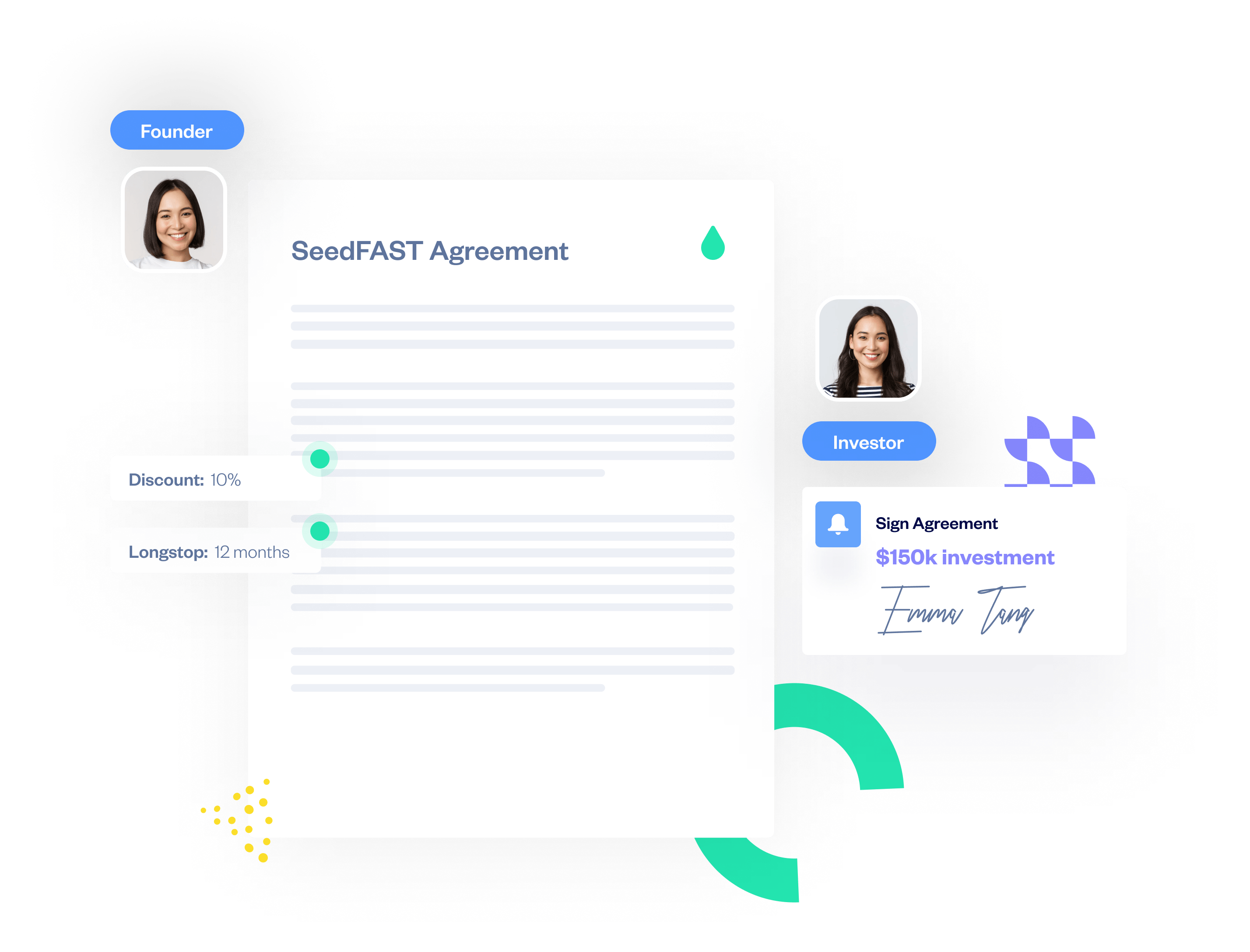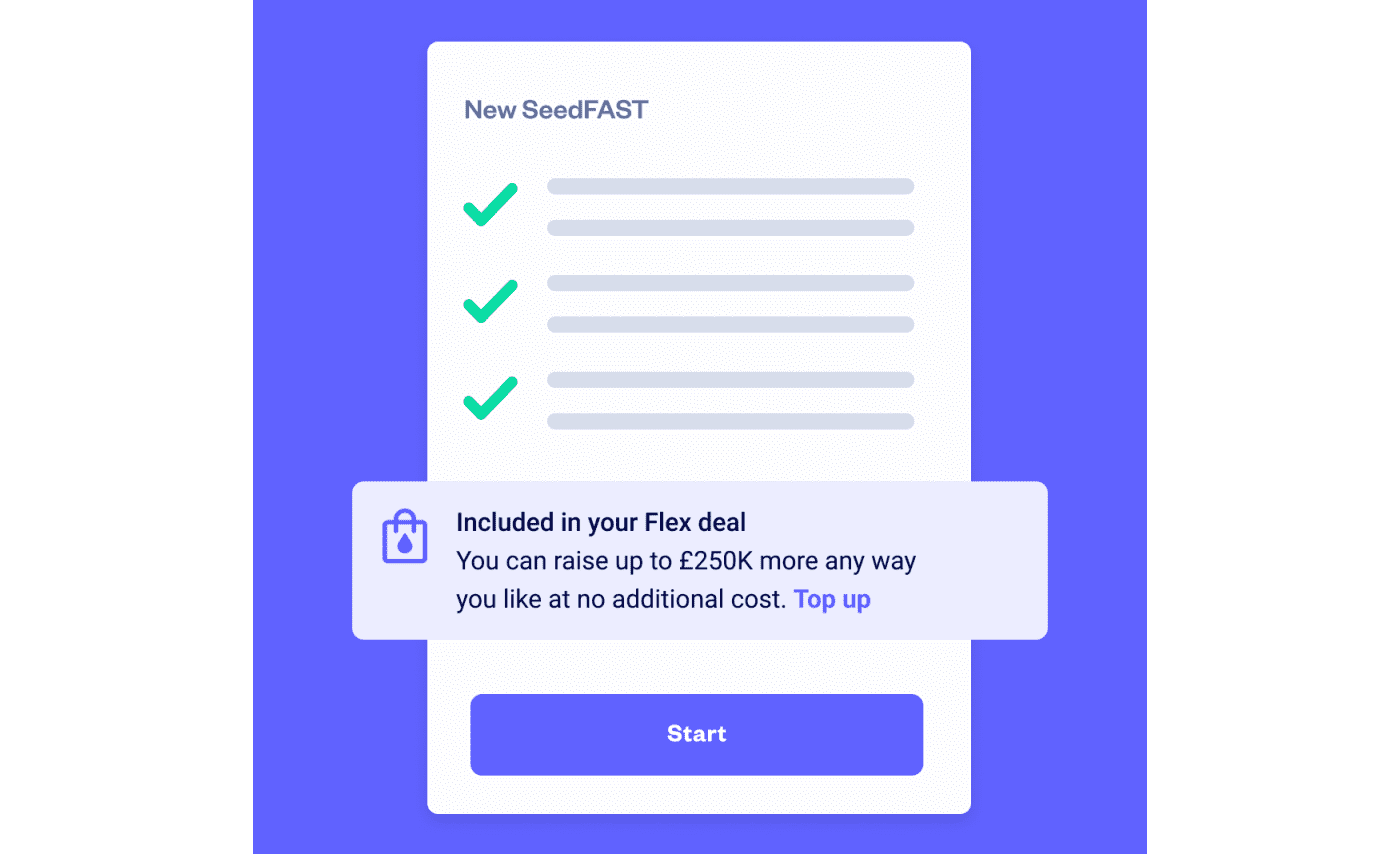How to pick the right deal terms for your SeedFAST
Raise as and when you need to with SeedFASTs. We explain key deal terms and dig into our data to explain what's standard...
An Advance Subscription Agreement (ASA) allows investors to ‘pre-pay’ for shares. For both founders and investors, ASAs can be a faster, more direct and more flexible way to get funds into the startup compared to a traditional ‘priced’ equity round, where the startup raises funds at a predetermined valuation.
We’ve seen Advance Subscription Agreements skyrocket in popularity over the past few years on SeedLegals. In this post, we explain what they are, why they’re a powerful alternative to a full round and how to use them.
✓ Create, share, sign, store online
✓ Expert help included
✓ SEIS/EIS friendly
✓ Internationally accepted
An advance subscription agreement (ASA) is a type of funding agreement between investors and a company. Under an ASA, investors commit to providing capital to the startup immediately in exchange for the right to receive shares at a fixed point in the future.
The terms of the agreement specify the trigger event – usually it’s a new funding round. If no trigger event happens before the specified deadline – the longstop date – then the agreement converts into shares at the pre-agreed longstop valuation.
For companies, the benefit of an Advance Subscription Agreement is obvious. You get access to cash much earlier than you would if you were negotiating a full funding round.
What’s in it for investors? By committing earlier, they can secure their right to shares at a lower valuation than they would during a round. Plus, companies can add an extra incentive to encourage investors to commit their capital early, by offering the ASA investor a discount on the shares as a reward for coming in early.
Anthony RoseBasically, a SeedFAST is an agreement that says: “You give me money now, and I’ll give you shares when I do my next funding round. To incentivise you to give me the money now, I’ll give you a discount, for example of 10%, compared to the valuation the investors will pay in my next round. And, if I don’t do that funding round within (typically, for SEIS/EIS compatibility) 6 months, then your investment will convert into shares at a valuation of, for example, £3,000,000”
CEO & co-founder,
Read more of Anthony’s insights: How to pick the right terms for your Advance Subscription Agreement
An Advance Subscription Agreement allows startups to secure funding from investors upfront even before a valuation has been set, and receive investment on a rolling basis.
Here are the terms you’ll specify in your Advance Subscription Agreement:
Gabriela SuarezDiscounts and caps are investor-friendly provisions – a founder doesn’t have to offer them straight away, or even at all. But they can be used to sweeten the deal and get an investor across the line.
They’re also commonly used for foreign investors who can’t benefit from SEIS/EIS tax relief, so they get a discount instead.
Agile Funding Expert,
Dig deep into the data from 2,000+ funding rounds completed on SeedLegals and exclusive insights into the key terms that founders and investors negotiate.
Analyse termsGabriela SuarezKeep a careful eye on the amount of equity you’ll be giving away when the ASA converts. Because the idea of instant fundraising is so powerful, some founders can overlook this part of the equation, and later be surprised to find they’re obligated to give more equity than they originally intended when they set up the ASA.
We recommend having a firm idea as to what valuation you want your ASA to convert at. This will help you to calculate how much equity your proposed investments will give away, and help you set a clearly defined longstop valuation for your ASA.
Agile Funding Expert,
In the US, the standard pre-funding round agreement is Y Combinator’s SAFE (Simple Agreement for Future Equity).
The broad principles are the same. But because the YC SAFE template is written for US law and uses US terminology (fair enough), if you use a YC SAFE this could cause complications for your company further down the line because:
We created this agreement to be as familiar as possible to a US investor who’s used to the actual YC SAFE template. We intentionally limited the changes to only the things needed to make it work for English law and UK companies.
Advance Subscription Agreements used to be relatively uncommon in the UK. Before SeedFASTs came along and changed the game, founders who wanted to raise before a funding round were limited to convertible loan agreements.
As the name suggests, the convertible loan agreement functions like a loan. The investment gives investors debt in your company, which is either converted into shares at the next funding round or at the longstop date or is paid back (often with interest).
Convertible debt allows investors to hedge their bets and therefore might appeal to most risk-averse investors. For founders, they’re often a less beneficial way to raise because:
Mix and match SeedFASTs, SeedNOTEs, Instant Investment and funding rounds for one fixed annual fee.
Flex my fundraiseFor the Advance Subscription Agreement investment in your company to be eligible for SEIS/EIS tax relief, it must:
The investment must also follow the other SEIS/EIS investor rules and company rules.
The requirement that sometimes causes confusion is the gross assets test. When you issue the ASA shares, your company can’t have more than £350,000 (SEIS) or £15 million (EIS) in gross assets. The rule applies to the date you issue the shares, not the date on which you sign the Advance Subscription Agreement.
Gabriela SuarezSeedFASTs (the SeedLegals ASA) are fully S/EIS compatible and we make sure your agreement stays compliant no matter what terms you set. For example, if you’re raising SEIS and EIS funds simultaneously, our platform cleverly issues the shares in the necessary order so that you stay S/EIS-compliant. Our team is on hand to explain anything you need, including the rules about the gross assets test.
The most important rules to remember are that the shares need to be issued within six months of both the agreement being signed and the funds received, so your ASA needs to convert within that time. Remember to take this into account when you plan your fundraising.
Agile Funding Expert,
When the investor comes to claim their SEIS/EIS tax relief, they’ll need to know which date and tax year applies to their investment.
The date that an investor’s SEIS/EIS investment is deemed to have been made is the day that they were issued their shares, not the day they signed the Advance Subscription Agreement. This means that the tax year in which the SEIS/EIS benefit is given is the tax year when the funding round took place, not the tax year in which the SeedFAST investment was made.
The good news is that HMRC allows investors to backdate their SEIS/EIS claim to the previous tax year. There are full details on HMRC’s guide to self assessment and SEIS/EIS.
So if your investors make investments in your company via an Advance Subscription Agreement today, even if it only converts into shares in the next tax year, they’ll be able to retrospectively claim their SEIS/EIS tax deduction then, for this tax year.
Read more: SEIS Compliance – how to make sure your investors get their tax relief
On SeedLegals we’ve made it super simple and quick to create an Advance Subscription Agreement. It’s called SeedFAST and with it you can:
It takes just minutes to create your SeedFAST Advance Subscription Agreement on SeedLegals. And it’s fully integrated with our online signing process, digital cap table, share certificates and board management tools.
Need more than one SeedFAST? On SeedLegals you can duplicate terms from previous SeedFASTs to save time and effort when you’re raising from multiple investors.
Need help figuring out your funding strategy? Or how SeedFASTs could fit into your fundraising? Use the form below to choose a time for a free call with a SeedLegals funding strategist.









